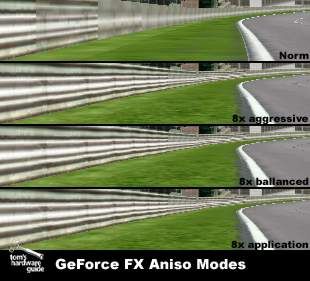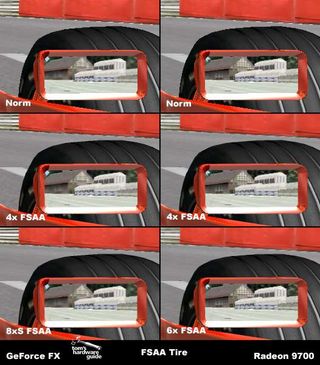Strike Force: The new ATI Radeon 9800, 9600 and 9200 Series
Anisotropic Filtering, Continued

Click image for uncompressed bmp version.
We couldn't tell any differences whatsoever between the different aniso performance settings on the GeForceFX in this game. We're not sure what caused it.

Click image for uncompressed bmp version.
On the Radeon, on the other hand, we could easily spot the differences between the quality settings. In 8x Performance mode, the mipmap transitions are easily discernable. In 16x, the barrier looks much crisper than in 8x.
FSAA
Since NVIDIA's driver still seems to be having some trouble with 2x FSAA mode (screenshots issue), we'll limit our evaluation to 4x and 8xs modes, or 6x mode, in ATi's case. We'll go into more detail on the different FSAA modes of these cards in a later article.

Click image for uncompressed bmp version.
In 4x mode we can see slight differences when looking at the tire. Both cards do well when drawing the tire's curvature. With almost horizontal and vertical edges, the FX's image shows more jagged edges, however. NVIDIA's 8xs setting does not improve image quality any further. With ATi's 6x setting, on the other hand, there are no longer any aliasing artifacts around the tire.
Stay on the Cutting Edge
Join the experts who read Tom's Hardware for the inside track on enthusiast PC tech news — and have for over 25 years. We'll send breaking news and in-depth reviews of CPUs, GPUs, AI, maker hardware and more straight to your inbox.
Current page: Anisotropic Filtering, Continued
Prev Page Anisotropic Filtering Next Page FSAA, ContinuedMost Popular

